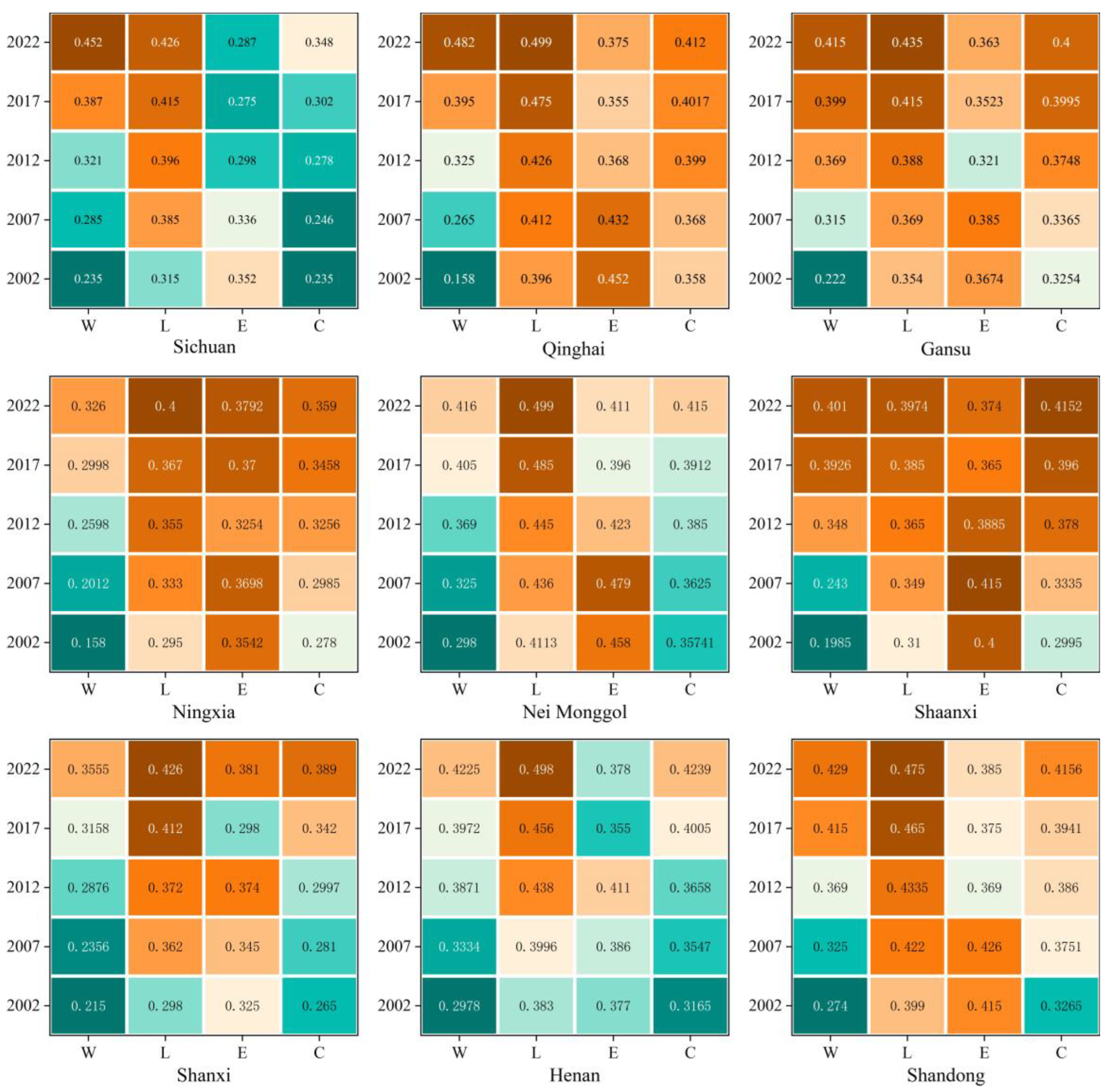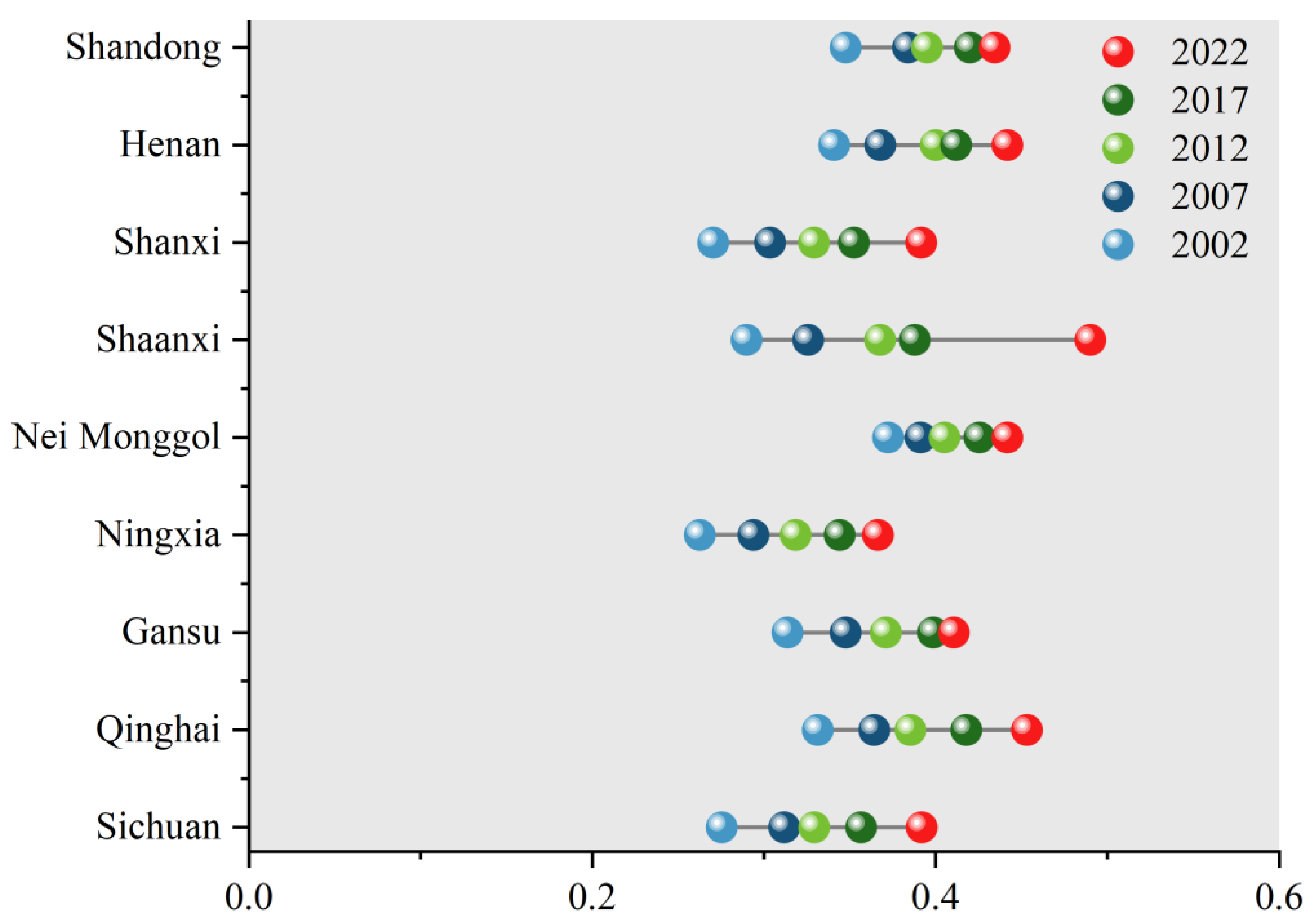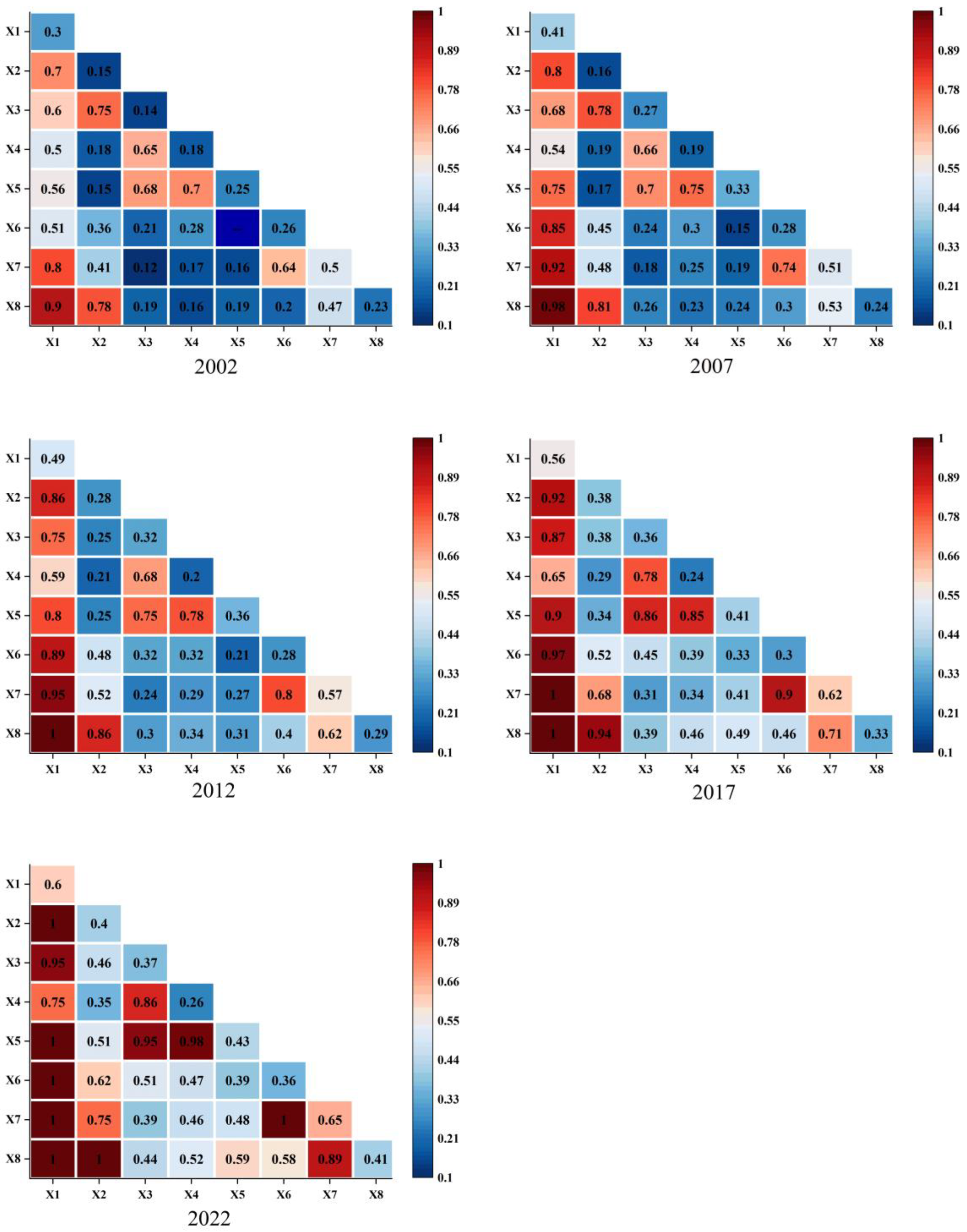Coordination Analysis and Driving Factors of “Water-Land-Energy-Carbon” Coupling in Nine Provinces of the Yellow River Basin
Abstract
1. Introduction
2. Materials and Methods
2.1. Overview of the Study Area and Date Source
2.1.1. Overview of the Study Area
2.1.2. Date Source
2.2. Multidimensional Evaluation Model
2.2.1. Evaluation Index System Construction
2.2.2. Index Weight Determination
2.2.3. “W-L-E-C” System Coupling-Coordinated Development Index
2.3. Driving Factor Analysis
2.3.1. Factor Analysis
- (1)
- Calculate the contribution degree of the -th evaluation index as follows:where is the weight value of the criterion layer corresponding to the indicator.
- (2)
- Calculate deviation as follows:
- (3)
- Calculate the obstacle degree of each evaluation index as follows:
2.3.2. Single Subsystem Indicator Results
3. Results and Discussion
3.1. Analysis of Coordinated Development of “W-L-E-C” Coupling System
3.1.1. Single Subsystem Indicator Results
3.1.2. WLECNI Index Results
3.2. Analysis of the Factors of Coordinated Development of “W-L-E-C” System Coupling
3.3. Interactive Detection and Analysis of “W-L-E-C” System Driving Factors
4. Conclusions
Author Contributions
Funding
Data Availability Statement
Conflicts of Interest
References
- Han, Y.; Li, J.; Zhao, M.; Guo, H.; Wang, C.; Huang, H.; Cao, R. Analysis of rainfall abundance and drought occurrence and probability of flood and drought occurrence in Yellow River Basin based on Copula function family. J. Hydrol. Reg. Stud. 2025, 58, 102242. [Google Scholar] [CrossRef]
- Li, S.; Xiang, N.; Shu, C.; Xu, F. Unveiling the industrial synergy optimization pathways in Beijing-Tianjin-Hebei urban agglomeration based on water-energy-carbon nexus. J. Environ. Manag. 2025, 376, 124528. [Google Scholar] [CrossRef] [PubMed]
- Yin, L.; Li, H.; Liu, D.; Zhang, L.; Wang, C.; Li, M.; Faiz, M.A.; Li, T.; Cui, S. Interpretation and Comprehensive Evaluation of Regional Water–Land–Energy Coupling System Carrying Capacity. Sustainability 2025, 17, 1669. [Google Scholar] [CrossRef]
- Zhou, H.; Liu, J.; Gao, C.; Li, W.; Ou, S.; Zhou, Y.; Luan, Q. Copula-based joint impact assessment of rainfall and tidal level on flood risk in tidal-influenced plain river network areas, Taihu Lake Basin. J. Hydrol. 2025, 653, 132785. [Google Scholar] [CrossRef]
- Wakchaure, G.; Minhas, P.; Biswas, A.; Meena, K.K.; Pradhan, A.; Gawhale, B.; Choudhary, R.; Kumar, S.; Fagodiya, R.K.; Reddy, K.S.; et al. Assessment of gains in productivity and water-energy-carbon nexus with tillage, trash retention and fertigation practices in drip irrigated sugarcane. Renew. Sustain. Energy Rev. 2025, 211, 115294. [Google Scholar] [CrossRef]
- Xu, W.; Wang, H.; Zhao, X.; Zhao, D.; Ding, X.; Yin, Y.; Liu, Y. Study on Evaluation and Dynamic Early Warning of Urban Water Resources Security. Water 2025, 17, 242. [Google Scholar] [CrossRef]
- Wu, L.; He, Y.; Tan, Q.; Zheng, Y. Land-use simulation for synergistic pollution and carbon reduction: Scenario analysis and policy implications. J. Environ. Manag. 2024, 356, 120603. [Google Scholar] [CrossRef]
- Li, J.; Zhao, M.; Han, Y.; Wei, J. Assessment on water cycle health in the Central Plains Urban cluster based on the DSWU NWU SWS NWS A—WCHI model. Ecol. Indic. 2023, 157, 111236. [Google Scholar] [CrossRef]
- Wu, Z.; Fan, Y.; Zhang, S.; Qian, X.; Wang, G. Dynamic assessment of water resources carrying capacity under human impacts on the water cycle: A finer perspective at the spatiotemporal scale of basin. J. Clean. Prod. 2025, 486, 144602. [Google Scholar] [CrossRef]
- Lyu, H.; Qiao, J.; Fang, G.; Liang, W.; Tang, Z.; Lv, F.; Zhang, Q.; Qiu, Z.; Huang, G. Variations in Water Stress and Its Driving Factors in the Yellow River Basin. Land 2024, 14, 53. [Google Scholar] [CrossRef]
- Ma, D.; Duan, S.; Zhang, X.; Xu, B.; Xu, Y. Spatiotemporal Dynamic Assessment of Water Resources Carrying Capacity and Identification of Obstacle Factors in Yunnan Province Based on Grey Water Footprint Theory. Water 2024, 16, 3651. [Google Scholar] [CrossRef]
- Sobkowiak, L.; Wrzesiński, D. Impacts of Climate Change on Water Resources: Assessment and Modeling—First Edition. Water 2024, 16, 3578. [Google Scholar] [CrossRef]
- Kang, Y.; He, S.; Ni, T.; Wang, J.; Liu, L. Analysis of water–energy–carbon coupling and influencing factors in food production. J. Water Clim. Change 2024, 15, 5939–5956. [Google Scholar] [CrossRef]
- Hadipour, M.; Pourebrahim, S.; Heidari, H.; Nikooy, F.; Ahmed, A.N.; Ern, C.J. Evaluation of water resource balance in the Urmia Lake Basin: Integrating carrying capacity and water footprint model for sustainable management. Ecol. Indic. 2024, 166, 112464. [Google Scholar] [CrossRef]
- Du, L.; Niu, Z.; Zhang, R.; Zhang, J.; Jia, L.; Wang, L. Evaluation of water resource carrying potential and barrier factors in Gansu Province based on game theory combined weighting and improved TOPSIS model. Ecol. Indic. 2024, 166, 112438. [Google Scholar] [CrossRef]
- Yu, L.; Peng, K.; Huang, Y.; Peng, K.; Huang, Y.; Chen, F.; Chen, S.; Xia, Y.; Huang, X.; Ni, X.; et al. Application of a water-energy-carbon coupling index to evaluate the long-term operational stability of the anaerobic-anoxic-oxic-membrane bioreactor (A2/O-MBR) process under the influence of rainstorms. Water Res. 2024, 255, 121489. [Google Scholar] [CrossRef]
- Feng, Y.; Wang, J.; Ren, X.; Zhu, A.; Xia, K.; Zhang, H.; Wang, H. Impact of water utilization changes on the water-land-energy-carbon nexus in watersheds: A case study of Yellow River Basin, China. J. Clean. Prod. 2024, 443, 141148. [Google Scholar] [CrossRef]
- Li, J.; Zhao, M.; Han, Y.; Wei, J. Analysis of water resource ecological optimization and obstacles based on the water resources-socio-economic-ecological environment model framework—A case study of the core area of the Central Plains urban agglomeration. Front. Ecol. Evol. 2023, 11, 1263601. [Google Scholar] [CrossRef]
- Jiang, W.; Zhang, Z.; Wen, J.; Yin, L.; Song, B. Spatio-temporal variation and influencing factors of industrial carbon emission effect in China based on water-land-energy-carbon nexus. Ecol. Indic. 2023, 152, 110307. [Google Scholar] [CrossRef]
- Zhao, M.; Li, J.; Zhang, Y.; Han, Y.; Wei, J. Water cycle health assessment based on combined weight and hook trapezoid fuzzy TOPSIS model: A case study of nine provinces in the Yellow River basin, China. Ecol. Indic. 2023, 147, 109977. [Google Scholar] [CrossRef]
- Yao, X.; Chen, W.; Song, C.; Gao, S. Sustainability and efficiency of water-land-energy-food nexus based on emergy-ecological footprint and data envelopment analysis: Case of an important agriculture and ecological region in Northeast China. J. Clean. Prod. 2022, 379, 134854. [Google Scholar] [CrossRef]
- Lyu, K.; Tian, J.; Zheng, J.; Zhang, C.; Yu, L. Evaluation of Water–Carbon–Ecological Footprint and Its Spatial–Temporal Changes in the North China Plain. Land 2024, 13, 1327. [Google Scholar] [CrossRef]
- Jin, K.; Zhang, S.; Yang, Y.; Chen, X.; Wang, S.; Li, T.; Wang, Y. Evaluation of water-carbon-ecological footprints and its spatial–temporal pattern in the central plains urban agglomeration. Ecol. Indic. 2023, 155, 110982. [Google Scholar] [CrossRef]







Disclaimer/Publisher’s Note: The statements, opinions and data contained in all publications are solely those of the individual author(s) and contributor(s) and not of MDPI and/or the editor(s). MDPI and/or the editor(s) disclaim responsibility for any injury to people or property resulting from any ideas, methods, instructions or products referred to in the content. |
© 2025 by the authors. Licensee MDPI, Basel, Switzerland. This article is an open access article distributed under the terms and conditions of the Creative Commons Attribution (CC BY) license (https://creativecommons.org/licenses/by/4.0/).
Share and Cite
Zhang, D.; Jing, M.; Chang, B.; Chen, W.; Li, Z.; Zhang, S.; Li, T. Coordination Analysis and Driving Factors of “Water-Land-Energy-Carbon” Coupling in Nine Provinces of the Yellow River Basin. Water 2025, 17, 1138. https://doi.org/10.3390/w17081138
Zhang D, Jing M, Chang B, Chen W, Li Z, Zhang S, Li T. Coordination Analysis and Driving Factors of “Water-Land-Energy-Carbon” Coupling in Nine Provinces of the Yellow River Basin. Water. 2025; 17(8):1138. https://doi.org/10.3390/w17081138
Chicago/Turabian StyleZhang, Daiwei, Ming Jing, Buhui Chang, Weiwei Chen, Ziming Li, Shuai Zhang, and Ting Li. 2025. "Coordination Analysis and Driving Factors of “Water-Land-Energy-Carbon” Coupling in Nine Provinces of the Yellow River Basin" Water 17, no. 8: 1138. https://doi.org/10.3390/w17081138
APA StyleZhang, D., Jing, M., Chang, B., Chen, W., Li, Z., Zhang, S., & Li, T. (2025). Coordination Analysis and Driving Factors of “Water-Land-Energy-Carbon” Coupling in Nine Provinces of the Yellow River Basin. Water, 17(8), 1138. https://doi.org/10.3390/w17081138





